
The Malpighiales comprise one of the largest orders of flowering plants, containing about 36 families and more than 16,000 species, about 7.8% of the eudicots. The order is very diverse, containing plants as different as the willow, violet, poinsettia, manchineel, rafflesia and coca plant, and are hard to recognize except with molecular phylogenetic evidence. It is not part of any of the classification systems based only on plant morphology. Molecular clock calculations estimate the origin of stem group Malpighiales at around 100 million years ago (Mya) and the origin of crown group Malpighiales at about 90 Mya.
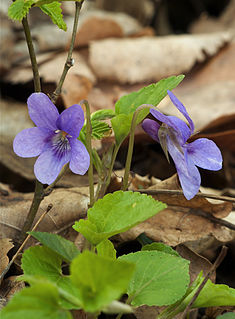
Viola is a genus of flowering plants in the violet family Violaceae. It is the largest genus in the family, containing between 525 and 600 species. Most species are found in the temperate Northern Hemisphere; however, some are also found in widely divergent areas such as Hawaii, Australasia, and the Andes.
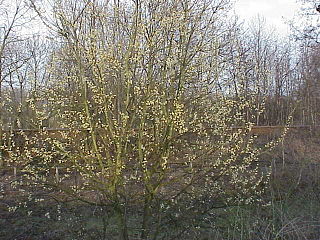
The Salicaceae are a family, the willow family, of flowering plants. The traditional family included the willows, poplar, aspen, and cottonwoods. Recent genetic studies summarized by the Angiosperm Phylogeny Group (APG) have greatly expanded the circumscription of the family to contain 56 genera and about 1220 species, including the Scyphostegiaceae and many of the former Flacourtiaceae.

Violaceae is a family of flowering plants established in 1802, consisting of about 1000 species in about 25 genera. It takes its name from the genus Viola, the violets and pansies.

Petrosaviaceae is a family of flowering plants belonging to a monotypic order, Petrosaviales. Petrosaviales are monocots, and are grouped within the lilioid monocots. Petrosaviales are a very small order of photosynthetic (Japonolirion) and rare leafless achlorophyllous, mycoheterotrophic plants (Petrosavia) found in dark montane rainforests in Japan, China, Southeast Asia and Borneo. They are characterised by having bracteate racemes, pedicellate flowers, six persistent tepals, septal nectaries, three almost distinct carpels, simultaneous microsporogenesis, monosulcate pollen, and follicular fruit.

Phyllanthaceae is a family of flowering plants in the eudicot order Malpighiales. It is most closely related to the family Picrodendraceae.

Ochnaceae is a family of flowering plants in the order Malpighiales. In the APG III system of classification of flowering plants, Ochnaceae is defined broadly, to include about 550 species, and encompasses what some taxonomists have treated as the separate families Medusagynaceae and Quiinaceae. In a phylogenetic study that was published in 2014, Ochnaceae was recognized in the broad sense, but two works published after APG III have accepted the small families Medusagynaceae and Quiinaceae. These have not been accepted by APG IV (2016).

Podostemaceae, a family in the order Malpighiales, comprise about 46 genera and ca 300 species of more or less thalloid aquatic herbs. Riverweeds adhere to hard surfaces in rapids and waterfalls of rivers. They are found mostly in tropical and subtropical areas worldwide. Many species are found in a very small geographic area, often even just a single river or waterfall. Because of their small range, many species are seriously threatened, especially from habitat loss. Riverweeds are submerged when water levels are high, but during the dry season they live a terrestrial existence, flowering at this time. Their root anatomy is specialized for the purpose of clinging to rocks, and in fact details of the root structure are one of the ways of classifying riverweeds.
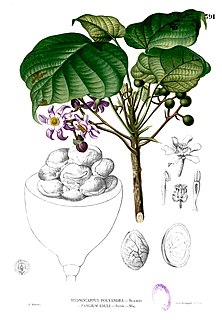
Achariaceae is a family of flowering plants consisting of 32-33 genera with about 155 species of tropical herbs, shrubs, and trees. The APG IV system has greatly expanded the scope of the family by including many genera previously classified in Flacourtiaceae. Molecular data strongly support the inclusion of this family in the order Malpighiales.

Siparunaceae is a family of flowering plants in the magnoliid order Laurales. It consists of two genera of woody plants, with essential oils: Glossocalyx in West Africa and Siparuna in the neotropics. Glossocalyx is monospecific and Siparuna has about 74 known species.

Triuridaceae are a family of tropical and subtropical flowering plants, including nine genera with a total of ca 55 known species. All members lack chlorophyll and are mycoheterotrophic. The heterotrophic lifestyle of these plants has resulted in a loss of xylem vessels and stomata, and a reduction of leaves to scales.
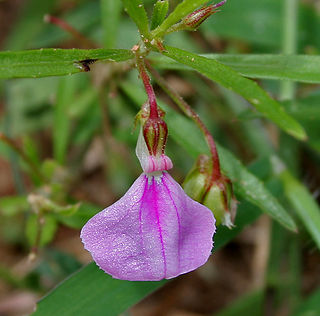
Hybanthus (greenviolet) is a genus of flowering plants in the family Violaceae. This genus name is Greek for "humpback flower", referring to the drooping pedicels of plants that are part of this genus. The genus is grossly polyphyletic and may contain up to nine different genera, of which Pombalia Vand., Cubelium Raf. and Pigea DC. have been previously recognised.

Picramniceae is a small, mainly neotropical family of three genera Alvaradoa, Nothotalisia and Picramnia. The family is the only member of the order Picramniales. Members of the family were formerly placed in the family Simaroubaceae or misidentified as species in the family Sapindaceae, in the order Sapindales. The most recent standard classification of the Angiosperms distinguishes it as a separate family and order. It belongs to the malvids, one of the three groups that constitute the rosids. Picramniaceae include three genera with 49 known species.
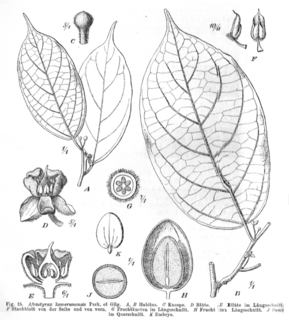
Huaceae is a family of plant in the rosids group, which has been classed in the orders Malpighiales, Malvales, and Violales or in its own order Huales. The APG II system placed it in the clade eurosids I, whereas the APG III system of 2009 and APG IV (2016) place it within the Oxalidales. The family is endemic to central Africa. It contains four species in the following two genera:

Peraceae Klotzsch is a family of flowering plants in the eudicot order Malpighiales. The family was segregated from the Euphorbiaceae by Johann Friedrich Klotzsch in 1859, and its uniqueness was affirmed by the Royal Botanic Gardens, Kew's Euphorbiaceae expert, Airy Shaw.

Schweiggeria is a genus of flowering plants in the violet family Violaceae, with one or two species, found in eastern Brazil.

Noisettia is a genus of flowering plants in the violet family Violaceae, with a single known species.
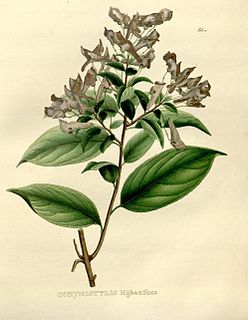
Calyptrion is a genus of flowering plants in the violet family Violaceae, with four known species.

Agatea is a genus of flowering plants in the violet family Violaceae, with seven accepted species, found in New Guinea and New Caledonia.

Anchietea is a genus of flowering plants in the violet family Violaceae, with six accepted species, found in tropical South America.



















